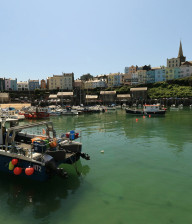

Carmarthenshire - Burry Port Beach
A popular sandy beach with an industrial past
Burry Port and Pembrey, like many other small towns and villages on the South Wales coast, were built on heavy industry. In the 1830s, Burry Port Harbour was constructed to transport coal from the Gwendraeth Valley. Along with tinplate, copper, silver, and lead works, prior to 1965, a munitions factory produced TNT and ammonium nitrate in relative safety among the Pembrey Burrows dunes.
Mind you, you wouldn't know the history to look at the area now as there's very little evidence of it now.
The Millennium Coastal Path, a 13-mile, traffic-free cycleway and pedestrian path, begins in Bynea in the east and passes through Burry Port before ending in Pembrey. One of the few reminders that this was once a huge coal exporting area is the Burry Port Lighthouse, which has stood on the west breakwater of the outer harbour since 1842. These days, the local yacht club uses it as a landmark. With its sailboats lying at anchor and stunning views of the Gower Peninsula, the harbourside makes for a pleasant stroll that's even better with an ice cream in one hand. Both sides of the harbour have sandy beaches that are open to dogs year-round, making them popular with both locals and tourists.
The dunes and beach of Cefn Sidan, Wales' longest beach, are on the southern edge of the country park. Additionally, it's received more coveted Blue Flag awards than any other beach in Wales - an impressive total of 23.
If you go on a clear day, you can see all the way to Caldey in the west, over to Lundy, and all the way to the Gower Peninsula. It's a popular spot for sunbathers, swimmers, and walkers alike.
At low tide, a darker side to this stretch of coast is revealed, when several ancient shipwrecks appear. Some of these ships were lured aground by gangs of looters who then robbed their valuable cargoes, while others were caught out by the ferocious tides and shallow banks of the Bristol Channel.
Location
Other Nearby Attractions

Carmarthenshire - Tenby Boat Trips

Carmarthenshire - Green Castle Wood Walks

Carmarthenshire - Garnffrwd Park

Carmarthenshire - Abergorlech Forest Biking

Carmarthenshire - Abergorlech Forest Walks

Carmarthenshire - Llansteffan Beach

Carmarthenshire - Pantybedw Fishery

Carmarthenshire - Carmarthen Golf Club & Driving Range

Carmarthenshire - Tywi Boat Club
